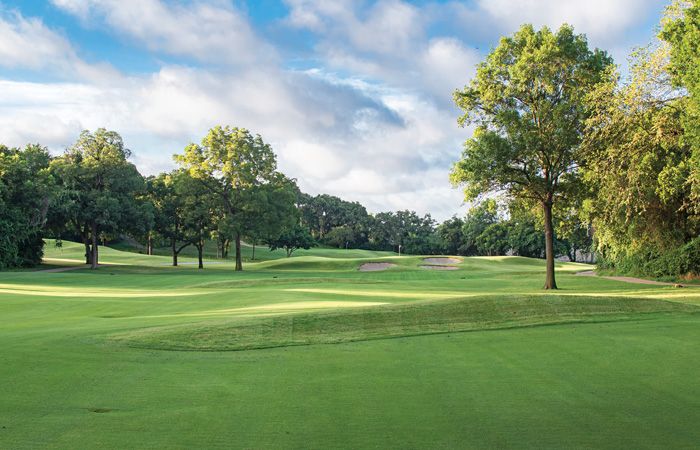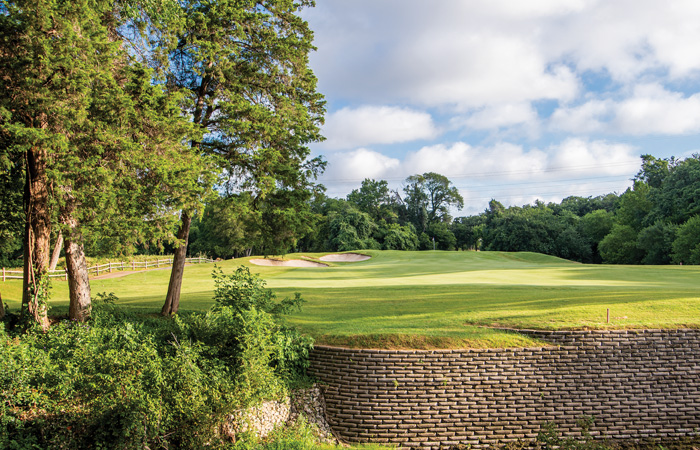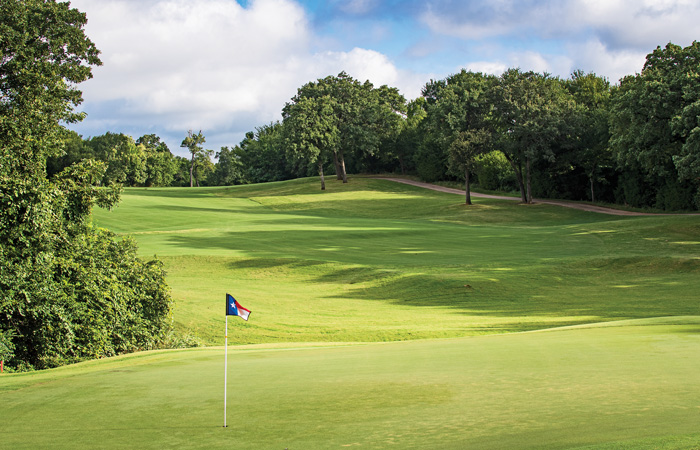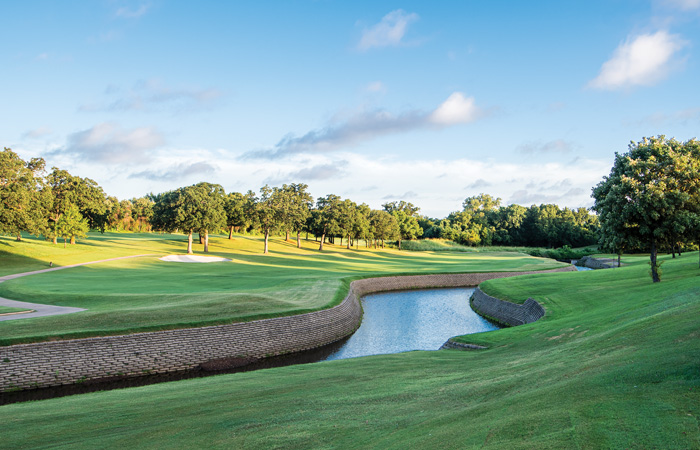When it first opened in 1997, Texas Star became a mid-cities staple for great conditions and a fun collection of holes. Tucked in Euless, this complex has long been a great destination for those groups that might be scattered across the area. One member of the foursome in Dallas? One in Fort Worth? One in Grapevine and another in Mansfield? Well that’s okay, just hit Texas Star. It’s about 25 minutes from all four. Despite the overwhelming wackiness that is 2020, the Star steams ahead with its affordable rates, great food and top-notch conditions.
As you arrive at Texas Star, the bag drop is alive with activity. The staff welcomes you and takes your clubs to your assigned cart as you make your way inside to pay.
The opening hole at Texas Star is a great way to ease into the round. Avoid left as it plays as O.B. A miss right won’t hurt you as the 9th fairway runs adjacent, but too far in that direction will leave a long approach shot. Be sure to consider pin placement as you decide which portion of the fairway to favor. A bunker left of the putting surface can be a tough up-and-down, so a short right miss would be the best bet if you are playing conservatively.
A short drive under the bridge takes players to the second hole. One of the most interesting features about this hole is the misdirection tee box. A relatively short dogleg right, this hole can give players fits as lining up the same direction as the tee box is cut will send tee shots directly into a large group of trees never to be seen again. For right handers, a cut three-metal or hybrid takes most of the trouble out of play, but don’t miss too far right, or you may be re-teeing one. Find the fairway and an elevated green awaits, which can eclipse at least some of the flagstick, making it hard to judge distance. Pins cut on the left need pinpoint accuracy, as anything beyond the flag will likely kick and roll off the back of the green, leaving a near impossible par.

Par is a good number on the second, making way for a birdie opportunity on the third. A short par-3 that plays slightly uphill. Called “High Mesa”, this one plays just under 150 from the tips, but the slight uphill can require an extra club. A shallow green front to back means the iron must be true to distance, as a trio of bunkers guard the surface. Find any of them, especially the two behind the green, and the second shot will require all of your short game skills. Secure a shot to the right portion of the green, and a birdie may find its way onto your scorecard.
With the opening trio of holes in the books, players begin to get into the meat and potatoes of the opening nine. The fourth hole, devoid of any dogleg, requires a good tee shot. Anything left sinks into tall native grasses and is likely lost, or if found, impossible to advance more than a few yards. Tee shots that head right can be in a thicket of trees or out of bounds, making a large number a possibility. Longer hitters will have a scoring club in hand to a deep green front to back, so be sure the yardage is true.
One of the defining features of the fourth and fifth holes at Texas Star are they run countered to the prevailing winds. In Texas, the predominant wind is usually out of the south, especially during the peak golf months. Of course, we may get the occasional north wind as well, but these two holes are across wind, with four running west to east and five running east to west. No. 5, called “Dagger” can be just that to your front nine score. This downhill, long four-par has O.B. right and tee shots seem to hang in the air forever as the south wind carries them toward the trouble. Players must commit to hitting the ball out over the left side of the fairway to account for the breeze, but a pull can find the trees on the left. This is one of the most demanding tee shots on the course. A fairway hit leaves a mid-iron, but the approach plays one club less than the number. No shame in a par here, and anything better is icing on the cake.
Admittedly, the sixth hole at Texas Star isn’t one of my personal favorites, but it is the definition of risk/reward. In my younger days, I would pull driver and rip a cut around the corner and find the ball somewhere within’ a flip wedge, but now that I don’t have the same firepower, an iron is usually my go-to play. At just 389 yards, bombers can get a tee shot up near the green, but a well-placed iron also proves to be an option for a possible birdie. If you do choose the driver, be careful of the large patch of native grass short and right of the green. It can swallow golf balls whole, and leave you second guessing the driver play. This is one of those holes that driver can result in feast or famine, whereas the iron play can get you through with a simple ho-hum par.
No. 7 features a similar tee shot to the one on the fifth but plays as the only front-nine par-five on this par-71 layout. Hit the driver in the fairway and expect some additional roll out on the downhill gradient. Those who execute can give the green a run in two with a mid-iron, but the shot is almost blind, as the putting surface is protected visually by a collection of trees about 30 yards short of the green. A high cut shot for right handers will give the best opportunity to reach the green but avoid missing too far right or your ball could careen down the hill and into the trees. If you fancy a lay-up, fire an iron down the left side and get a wedge in hand, which will allow you to put some spin on the ball to help hold the green. “Tombstone” is a birdie waiting to happen with an accurate tee shot.
No. 8 is the second of the par-3’s at Texas Star. This slightly uphill, 217-yarder demands a long iron off the tee and will test even the best ball-strikers. A deep bunker guards the front right of the putting surface and makes for a tricky up and down if tee shots find it. Bleed a ball too far right and long native grass can devour balls and bring big numbers into play.
The ninth hole is one of the quirkiest on the entire property. A lengthy par-4, this one, for most players will be two solid mid or long irons to reach the green in regulation. A creek that crosses the fairway at about 300 from the tips means it’s a bit of a tweener for the longer players. Those playing from a tee box or two up, will likely choose an iron for position and then find themselves about 175 or so from the green. Water right of the putting surface is the danger on approach, meaning the middle of the green and a two-putt is the smart play. It’s a fun hole, but one that can present plenty of danger, even for the single digit handicapper.

As you make the turn at Texas Star, you begin to feel the pressure mounting from all the demanding shots from the front-nine, however, there are plenty of scoring holes that remain. With two par-5’s on the back, the inward nine can play a touch easier than the front, and that begins with a par-5 at No. 10.
A severely uphill tee shot awaits, as the bombers can tickle the right side of the left fairway bunker and saw off some of the slight dogleg. Get a ball over the crest of the hill and added roll, coupled with a better angle can bring about the opportunity to reach the green in two, as the second shot plays back downhill. Beware if you do give the green a run, as it is narrow front to back and balls that hit the middle or back of the green can scream long and leave a carnival up-and-down attempt. A smart play is to lay-up and try to stick a wedge close and look to make a birdie putt.
The 11th hole at Texas Star is one of my personal favorites. A drivable par-4, this hole can really give players some much needed relief from a tough layout. The spilt fairway offers opportunity for a layup or for big hitters to green-light the driver and try to thread the needle onto the green. The danger of going for the green can be the rolling undulations short of the putting surface and a deep greenside bunker left. This hole is another great example of the course giving players the chance to think their way to a better score.
No. 12, known as “Bugle Ridge” requires two tough shots to reach the green in regulation. A large fairway bunker at the hard-turning dogleg can turn what looks to be a good tee shot into a long approach from sand, so be on the defensive against finding it. One thing that experience will teach you on this hole, is that the second shot plays about a club and a half downhill. Any ball landing in the middle or back portion of the green has little chance of staying there. Plan to land your approach a little short of the surface and once you arrive near the green complex, you will see your ball has likely trickled up to the front or middle. Don’t be long on the second, or you may never see your ball again.
13 is one of those holes you want to play again and again. The fairway sprawls across the terrain, rising up from the tee box to the crest of a hill and then back down again to the green, which plays about 75 feet below the landing area. If you choose to hit driver, favor the left side and watch the ball go carrying over the hill, but know that once you get to it, you may find a very awkward downhill lie. Getting the tee shot right to the top of the hill is a great plan, which should leave players with a level lie and a good look at the green. Remember the elevation change to the green below, as it will likely play a club or two less than the yardage reads. This is one of the most interesting holes at Texas Star.

A demanding par-3 awaits at the 14th. This hole plays a muscular 245 from the tips and is about a club uphill. It’s a long hole, so much so that you will often see even the longest players banging hybrids or even three-metals into this green. A tricky pair of bunkers short of the green await and can leave a difficult second. Let’s just say a three here is a great score and leave it at that.
There is a plethora of ways to attack No. 15 at Texas Star. I have seen guys drive the green and hit 8-iron off the tee. It’s really dealer’s choice off the tee box on this one. For me personally, it usually depends on pin placement for that particular round. If the pin is left (looking from the tee box), I will hit a driver or three-wood out to the right to be able to look down the length of the green on the approach, if the pin is right, I will sometimes lay-up and try to leave myself a good number. I say “sometimes” lay-up, because there are those rounds where I may want to attack or am not playing all that well and bash driver anyway, because why not? But if I’m thinking my way through, I want to leave the best angle possible relative to where the pin is cut.
The final three holes at Texas Star are definitely gettable. The par-3 sixteenth is a downhill, and usually down breeze hole that plays about 180 from the back tees. This number can be a bit deceiving though, for the two factors mentioned. Water right comes into play, especially with any pin back right. You must be certain of the adjusted yardage and commit to the shot or your round could be circling the drain with one swing.
No. 17 is a straightway par-4 that requires accuracy off the box. Favor the left center of the fairway for the best angle. Good tee shots leave a scoring club in hand and a great chance at birdie. Miss the fairway right and you will likely find a ball below your feet lie that makes it difficult to hit the green. And make note, any putts that are being lagged from front left of the green to back right will break hard right toward 18 tee box.
The final hole on this par-71 layout can be a tough finish, especially if there is a stiff south wind. A drive just left of the right fairway bunker is the aiming point but be mindful of the water all down the left. Only the long hitters can give this green a go in two, so an accurate layup down the left side is likely the play, which will leave a great angle to the last green. Anything better than par is a bonus, but a five is a great way to end the day.

The clubhouse at Texas Star is nice and accommodating, and the restaurant features good food and a small bar where you can eat or enjoy some libations after a day on the course. On Saturday and Sunday mornings, you will routinely see locals having breakfast in the clubhouse, even though they may not be teeing it up that day.
Overall, Texas Star is a great facility, the range, while not large is a good place to practice or loosen up pre-round, and a chipping and putting area will refine your short game if you’re looking to work on your game.
All the reasons mentioned are why Texas Star is routinely toward the top of our best of public list. Great golf, great food all at a reasonable price point. Be sure to add this course to your list of regular tracks to see in Dallas/Fort Worth.
Texas Star Golf Course
1400 Texas Star Parkway
Euless, Texas 76040
817-685-1865
www.texasstargolf.com